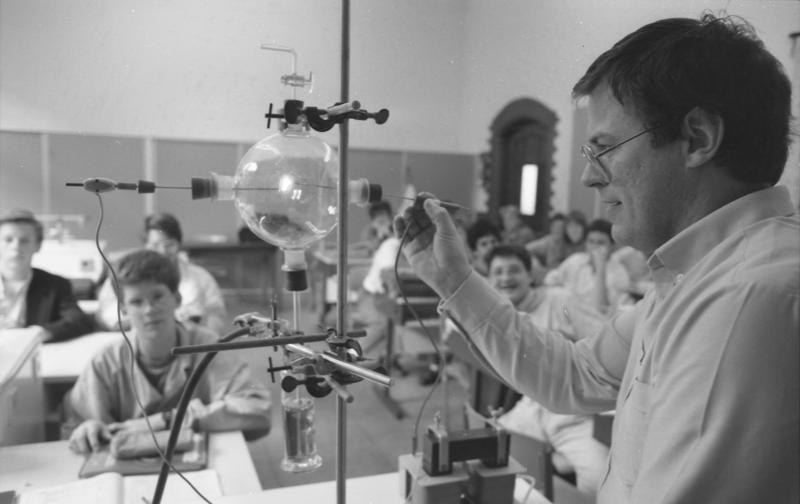Re-writing the sodium water reaction
Interview with
Scientists sometimes say of their discoveries that we'll need to "re-write the  textbooks" on the subject. But now researchers really have taken a red pen to the explanation for one of the most famous school chemistry experiments - the one when a lump of sodium metal burns when dropped into water, as science writer Mark Peplow explains to Chris Smith...
textbooks" on the subject. But now researchers really have taken a red pen to the explanation for one of the most famous school chemistry experiments - the one when a lump of sodium metal burns when dropped into water, as science writer Mark Peplow explains to Chris Smith...
Mark - It's a favourite school chemistry demonstration. You drop a chunk of sodium metal in a bowl of water and watch it scitter around on the surface, fizzing and popping as it reacts with water to make hydrogen gas. Potassium, it's even better. You throw that in and you can get quite a hefty explosion. But why does it explode?
Chris - The dogma that gets strutted out in the classroom is that the metal is so hot that it ignites the hydrogen that's being made and it burns.
Mark - That's exactly what we were told at school and what teachers continue to tell their pupils. But a team of chemists in Prague have now used high speed cameras to prove that something else is going on. Running at 10,000 frames per second, they videoed an alloy of sodium and potassium which is a liquid, dropping into water. After just 0.4 milliseconds, they saw little spikes of metal shooting out from the droplets of alloy which is far too fast to be caused by heating or hydrogen explosion. Around the same time, the water briefly turns a very distinctive dark blue colour.
Chris - Ooh
Mark - I know. It's very mysterious. So, to work out what was going on, the chemists did some computer simulations of the reaction. They calculated that each atom at the surface lost an electron within just a few Pico seconds of hitting the water. That's a trillionth of a second. That's roughly the time it takes for light to travel a millimetre. Now, when lots of electrons are dissolved in water, they create a blue colour, exactly what they saw in the video.
Chris - What's causing the little spikes of metal then?
Mark - Well, this is the cool bit. Once those electrons have left the metal droplet, that leaves a lot of positively charged metal atoms behind. Now, those repel each other like crazy, so strongly that they blast apart, forming those spikes. Now, this actually seems to resolve a question that some people have raised about the old explanation of this reaction. You'd expect all that hydrogen gas and steam roiling around the surface of the metal. You'd think that would prevent more water from reaching the fresh metal underneath and that would actually slow the reaction down. But the point is, the metal spikes can actually burst through that layer so the metal keeps reacting with the water.
Chris - Goodness! And what's the reason for the hydrogen then igniting? Is that genuinely just the heat from the metal of the reaction or is there something else triggering that?
Mark - No, that's right. The heat of the reaction is ultimately going to ignite the hydrogen. But that's happening much later than this first explosive process.
Chris - Now, the killer question here must be, what's the practical purpose of having done this study? Is it purely just academic interest or does this inform some other areas of chemistry that we haven't previously ventured into?
Mark - The researchers who did this in Prague say that their main motivation for doing this was just to try and understand this long standing puzzle of exactly what was going on in the reaction. And their hope really is that, we often say that this research will rewrite the textbooks, but in this case, they really hope that it will because they want to make sure that teachers are giving the true nuance picture of what's actually going on in this reaction to their students.
Chris - And the gold star for science writer, Mark Peplow for teaching it to us properly.









Comments
Add a comment